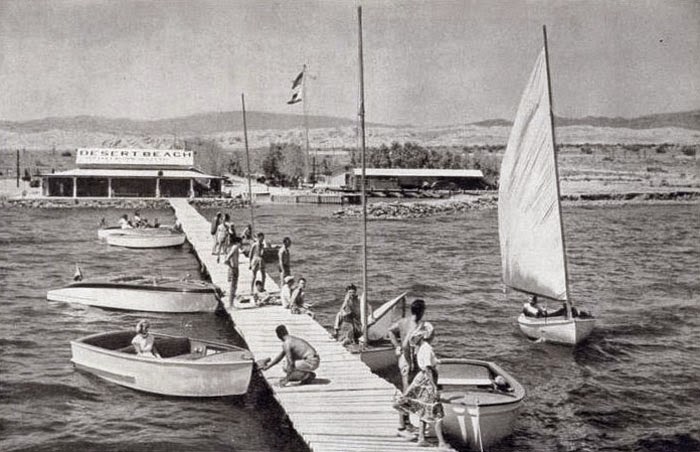Bombay Beach is a former resort/trailer court on the eastern shore of the Salton Sea, in Imperial county, California. To reach it, drive on California Highway 111 along the barren desert east of the Sea, and turn west on Avenue A.
Well, it does not look too bad. There is a store and mailboxes. Human habitation, perhaps?Oops, the view from Avenue A becomes a bit grim. To the north, beyond the one bush, is a dry and featureless plain.
To the south, well, it was trailer heaven once upon a time.
The gate leads to a sizable deserted parking lot at the plage. They were optimistic.
Continue to the end of Avenue A, and the levee protects the town from flooding. Drive up onto the levee, and the land beyond is a mess of twisted trailer and collapsed sheds. It looks like the debris I saw along the Mississippi coast after Hurricane Katrina, but the Salton Sea does not have hurricanes. Very odd.
In the water, the pilings are encrusted with salt, and the beach sediment consists of fish bone rubble.
At least someone had fun with this old chimney.
Back in town, Fifth Street was the waterfront (levee-front?) corniche. Maybe the graffiti is more interesting.
Turn back inland along Avenue G. Someone collected classic Volkswagen Beetles. Rather cool. Someone else collected classic tires. Less cool.
The well-known western author, Harold Bell Wright, wrote a novel about the formation of the present Salton Sea, The Winning of Barbara Worth. My daughter borrowed it from her local library. Her opinion was that it is one of those novels that does not age well. It lacks the pace or writing style that modern readers find interesting, but it does give an interesting window into the attitudes of the day. The primary assumption of the characters in the book is that by "reclaiming" the desert and making it fertile and lush, they are somehow doing a great work for the world or for God. The desert was something that was "broken" and had to be fixed. It is rather shocking to think that this was the attitude that caused us to make huge alterations to the West, and that a mere 100 years can shift attitudes so drastically.
Harold Bell Wright wrote The Winning of Barbara Worth while living in the tower at the Holt House, on Olive Avenue in Redlands, California. He modeled the protagonist on his host, Mr. Holt. Wright was a pastor, and possibly when the church could no longer afford his services, Mr. Holt provided him a place to stay.
My daughter drove me to Bombay Beach, as she knows my photographic interests. The ground-level photographs were taken with a Fuji X-E1 digital camera, with RAW files processed with Adobe Camera Raw and DxO Filmpack 3.





























-K25_resize.JPG)




















